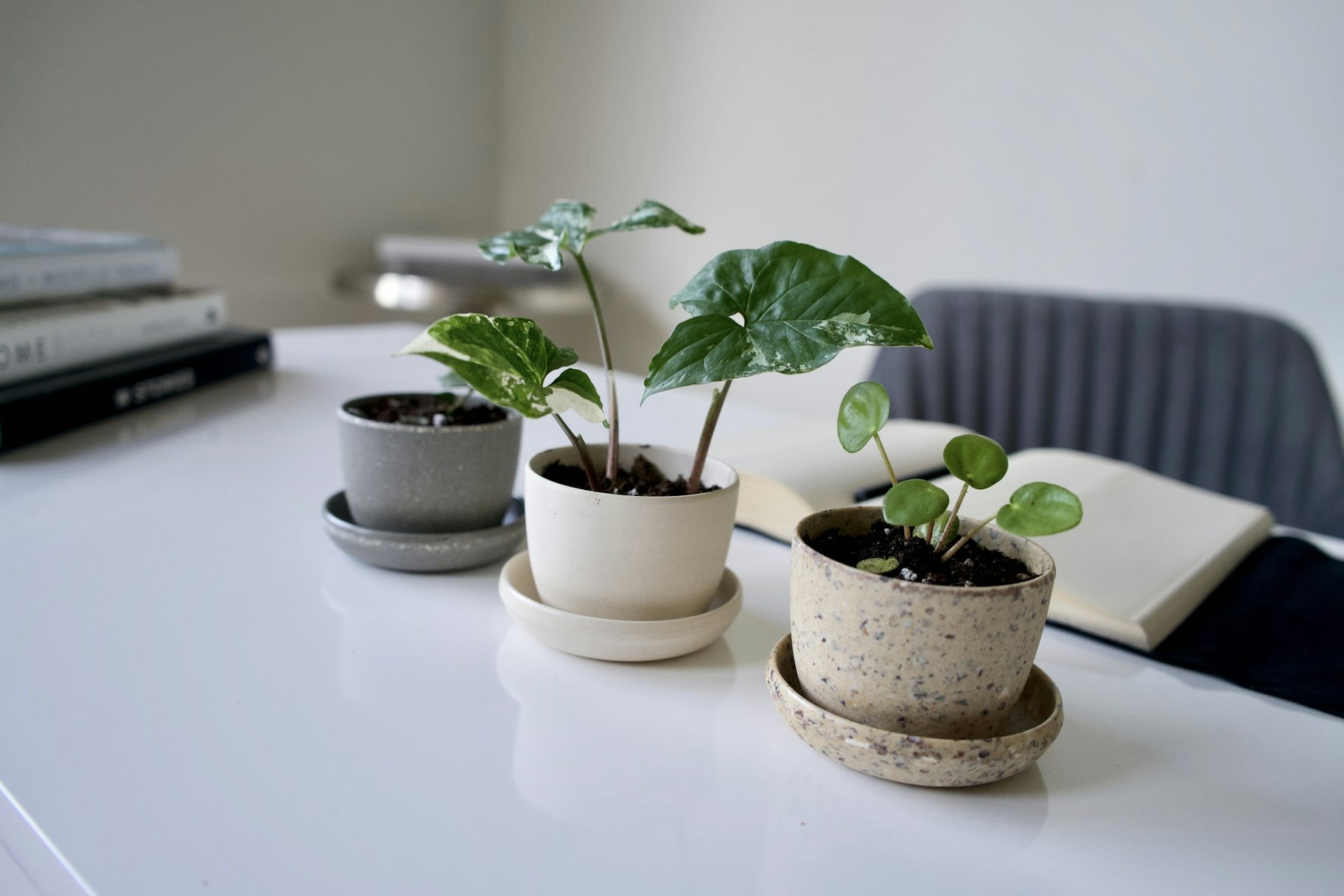Plants are the unsung heroes of our world. They help us enjoy a beautiful surrounding while offering therapeutic benefits that keep us healthy and sane. And it turns out, plants can even fill the sudden void in our social lives during events such as the COVID-19 pandemic. As more and more people buy plants for these reasons, you have the opportunity to make money by learning how to sell plants online.
In this beginner’s guide, we’ll go over the steps involved in starting a new plant selling business. If you have a green thumb and previous experience running a business, you’ll find it easier to follow them. But even if you don’t, you can still succeed as a plant entrepreneur—we’ve left some handy tips to help you navigate the foliage business world.



How to Start An Online Plant Business: 7 Steps
1. Decide what plants to sell
From herbs and spices to outdoor plants, seeds, and bulbs, the botanical world is filled with variety. Choosing what plants to sell usually involves considering not just your own interests but also the kind of products you have access to, whether you have the space to keep those items, and a few other things.
Some potential options for plants you can sell online include:
- Houseplants. Think indoor plants like cacti, succulents, ferns, and spider plants.
- Seeds and bulbs. Consider bulbs, seeds, and growing supplies to help customers grow from scratch.
- Plant care products. Think fertilizer, soil, grow lights, and special plant food. These products can also be sold in tandem with live plants.
- Home décor. Hanging planters, decorative plant pots, and trays can be sold independently or alongside the plants that fill them.
- Kits and terrariums. Offer a combination of plant suppliers and live plants for building terrariums at home.
- Subscriptions: Why not offer recurring plant shipments with a specific theme, like “seed of the month”?
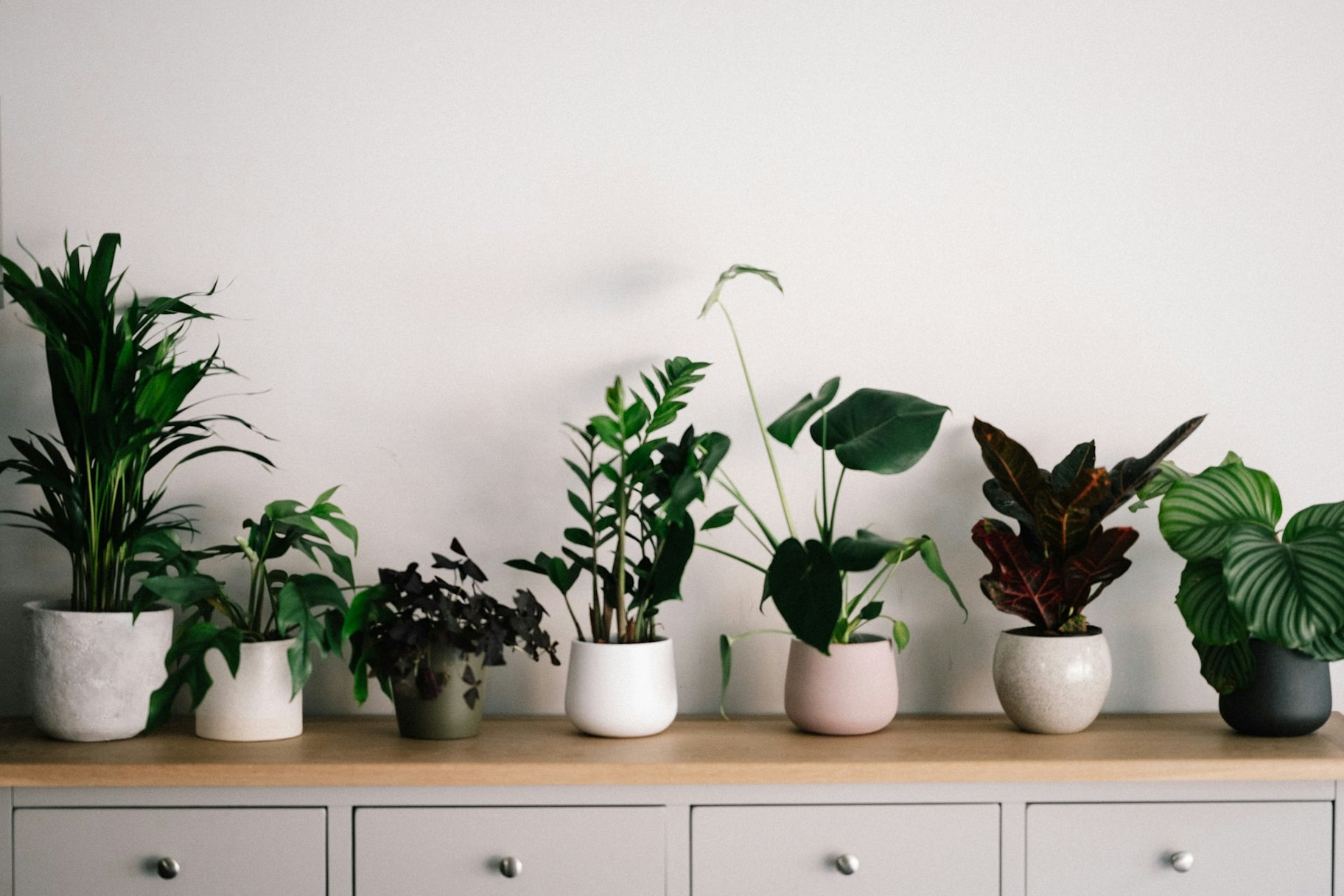
2. Source your plants
There are two popular ways to find the plants you need for your customers. The first, and most time-consuming, option is to grow your own plants to sell. You can grow plants in your garden, create a greenhouse, or even rent space at an allotment.
Growing plants requires a lot of know-how about caring for different plant species. You’ll also need to consider how you’ll scale production if your order numbers increase. Ask yourself, Do I have the right space and conditions to grow and care for plants?
A simpler option for many sellers is to source plants from greenhouses, nurseries, professional growers, and suppliers. You can visit local greenhouses in person or check out websites belonging to companies nearby. When looking for the best source of plants, remember to:
- Shop around. Different suppliers can offer different benefits. Some have low minimums for the number of plants you need to buy. Others can offer extra consulting, support, and services.
- Consider local growers. Local providers will often give you better deals since they don’t have to spend as much on packaging and shipping.
- Form relationships. Try to develop a positive relationship with your supplier. A good relationship with your supplier could lead to better deals in the long term.
- Understand seasonality. Consider what kind of plants will be in stock with different suppliers at certain times of the year. You may need to move from one supplier to the next throughout the year.
- Have multiple suppliers. If you only have one supplier and something goes wrong with their products, you’ll be in serious trouble. Sourcing from multiple suppliers ensures you always have a backup and are able to access a wider range of products.
- Consider dropshipping. If you’re worried about finding enough room for all your stock, you can look at dropshipping. Companies like House Plant Dropship will manage storage, packing, and shipping your products for you. This saves you a lot of time and money on fulfilling orders yourself.
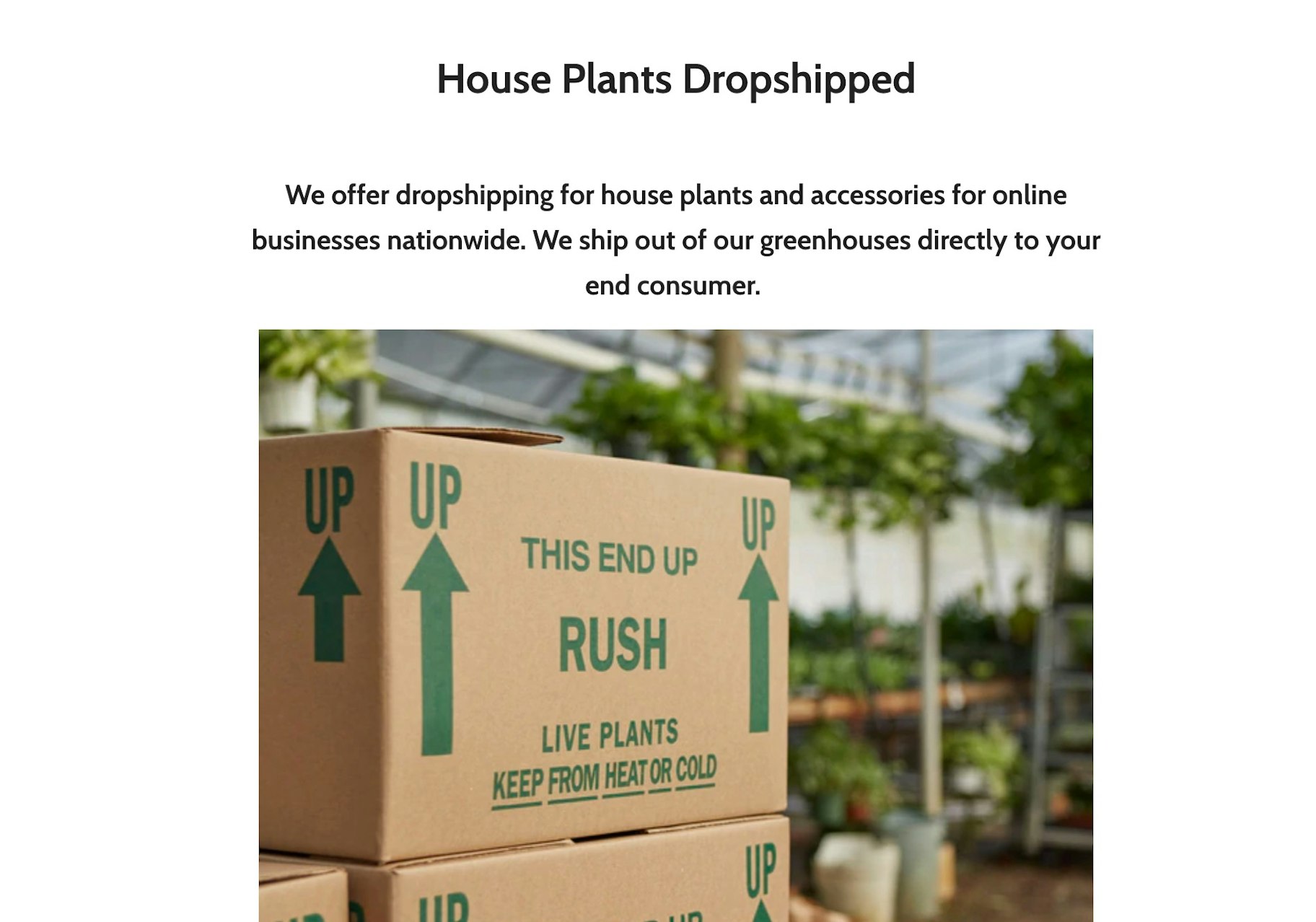
3. Photograph your plants
Product photography is crucial for drawing people’s attention, especially if you’re selling an item with a big focus on aesthetics (like plants and flowers). You can either hire a professional photographer or take the DIY route to plant photography. With either approach, follow the best practices of product photography that apply across all item categories.
Plant photography tips:
- Shoot in natural light. Natural lighting gives your customers a more realistic idea of the plants you’re selling. Steer clear of filters, as they can result in unmet customer expectations.
- Use your smartphone. With sharp, high-quality cameras, today’s smartphones are perfectly capable of shooting plant care tutorial videos, behind-the-scenes images, and other photos for use on ecommerce websites.
- Consider 3D photography. Getting your products shot in 3D will enable your customers to use AR technology to place plants in their homes.
- Take a lifestyle shot. Help your customer envision what your plant will look like by placing the item in a natural space, like a bedroom, living room, or dining room.
- Focus on the finer details. Consider taking close-up shots to help show the colors and textures in each plant.
4. Create an online plant store
To sell plants online, you’ll need to create a store website so you can showcase your range and accept orders from customers.
With Shopify, you can easily build a plant store, even if you have no coding or design skills.
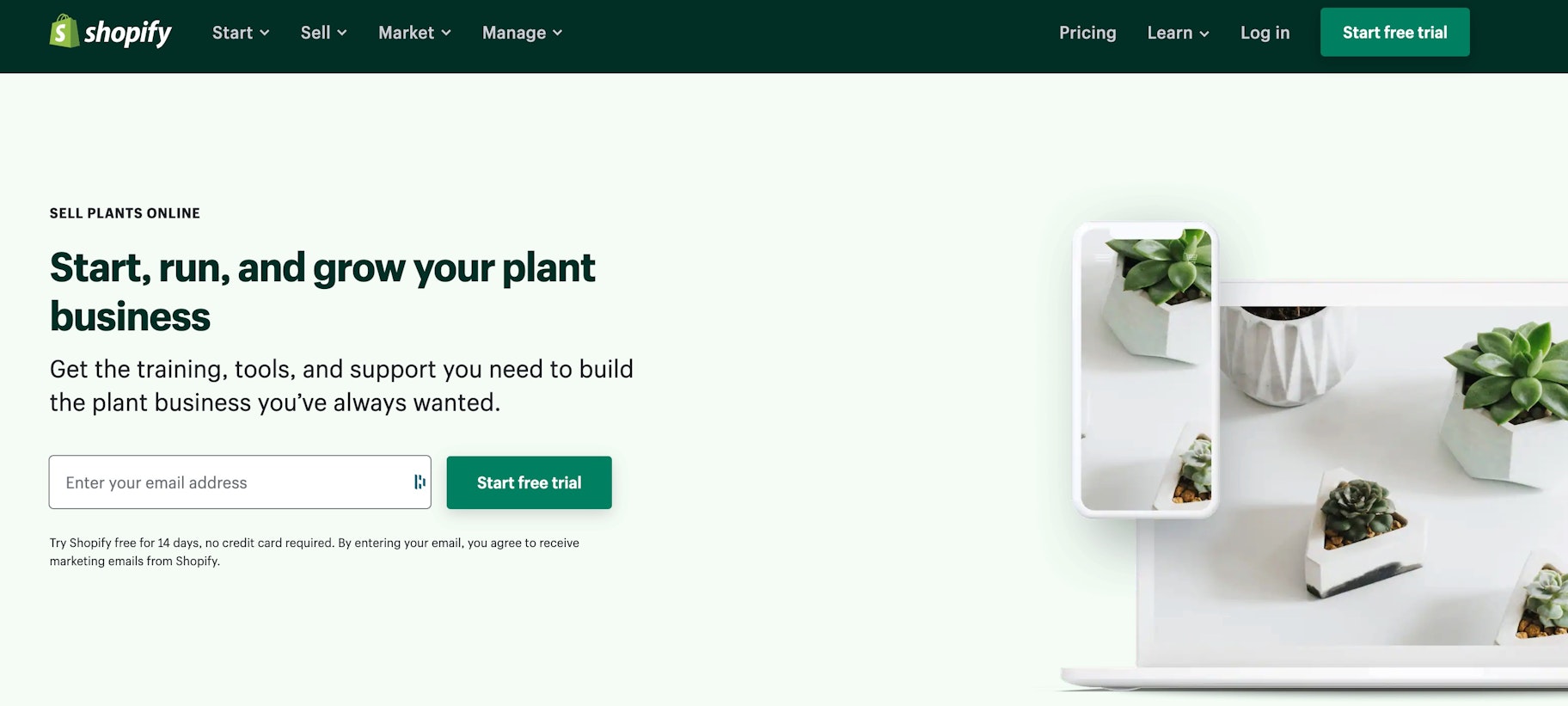
Choose from one of the preset themes (Narrative is great for beginner plant sellers) in the Shopify Themes store, then customize with your own colors, fonts, branding, and unique layout.
Though Shopify comes with all the essential functionality (marketing tools, payment gateways, etc.) you need to run a plant business, layering apps onto your online store is always an option. The Shopify App Store has plenty of them, spanning various categories that make it easier for you to operate a webstore. You’ll find apps for marketing, customer service, dropshipping, and more.
When it comes to your product pages, make sure to include standard information like plant description, size, and species, along with clear product images. Also consider using this space for education. For example, you can include useful details like ideal pH for growing conditions and offer plant care tips to build with the audience.
If you decide to create collections for your products, consider organizing them by size, species, or other helpful categories, such as “beginner friendly” and “pet friendly.”
5. Build your plant brand
Differentiating your plant store from other websites selling plants depends heavily on branding. Think about what makes you unique and use that as your value proposition. For instance, online plant retailer Grounded’s branding is rooted in the power of plants to bring mindfulness and peace into daily life—a proposition sprinkled throughout its website and marketing copy.
Got a brand story? Share it on your About page, on social media, and even on packaging. Outline your business values, share details on any charitable partnerships, and let customers envision your humble beginning. Additionally, offer educational content to show you’re knowledgeable and have high care for your products.
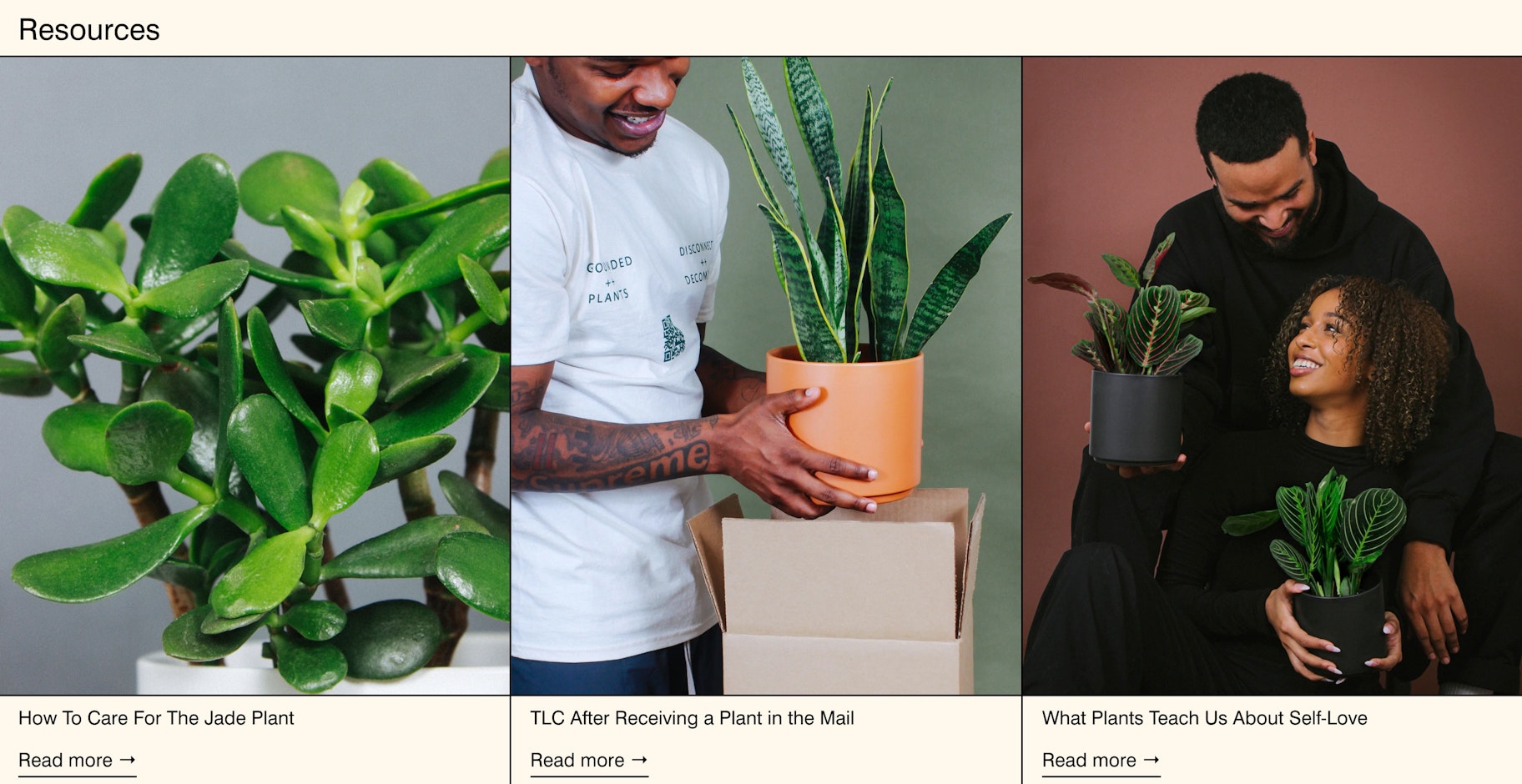
Don’t skip this step.
6. Price your plants
Pricing any product, including plants, can be difficult if you’re a new business. But doing some research into competitors to see what kind of prices other businesses are charging for similar products can give you a starting point. Also consider the general formula for pricing that involves:
- Knowing your costs of goods sold, packaging, and shipping
- Creating a small profit margin
- Addressing fixed costs (like the price of renting a greenhouse)
Prices for plants can differ depending on a number of factors. For instance, your target customer will be an important consideration. Some high-end plant and flower enthusiasts will be willing to pay more for a rare plant in good condition, whereas others may wish to buy in lots for a lower price.
Other factors to consider include:
- Seasonality. If you offer certain plants when they’re difficult to find elsewhere, you’ll be able to charge a small premium on whatever you sell. To take advantage of seasonality, however, you’ll need access to a reliable supply chain with a diverse selection of products.
- Rarity. Some plants and seeds are much harder to find than others. Knowing which plants are most in demand among your target audience will help you determine the right pricing.
- Market price. Consider the standard pricing range used by most people in your industry. While your brand might offer extremely high-quality seeds and starter plants, pricing should still be similar to what customers can find elsewhere online.
7. Package and ship your plants
Packaging and shipping plants correctly can be complex because, in some cases, you’ll be shipping a “living thing.” You’ll need to take extra precautions to protect the product, which means researching the best ways to keep everything from leaves to stems to flower seeds safe.
When packing and shipping your plants, make sure to:
- Determine rules and regulations. There are rules governing how certain types of organic matter and soil can travel across borders. For instance, Canada allows imports of soil from the US, provided the right documentation is included, but it doesn't allow soil imports from other countries.
- Research the climate. If your plants are going to be subject to extreme temperatures during transit, you may need to arrange heat packs or hire specialist vans to keep them nourished.
- Take protection measures. There are numerous steps you can take to secure and protect your plant, from wrapping cardboard around the base of the plant to ensuring the pot is coated in bubble wrap. Don’t cut corners here.
- Choose carriers carefully. Sometimes, the safest way to ship a plant is through express delivery. Choosing carriers who work seven days a week will ensure your plants aren’t sitting around without light or care for too long.
- Reduce shipping costs where possible. In some cases, you may be able to ship your plants without soil and other accessories that can add weight and, therefore, increase your shipping price.
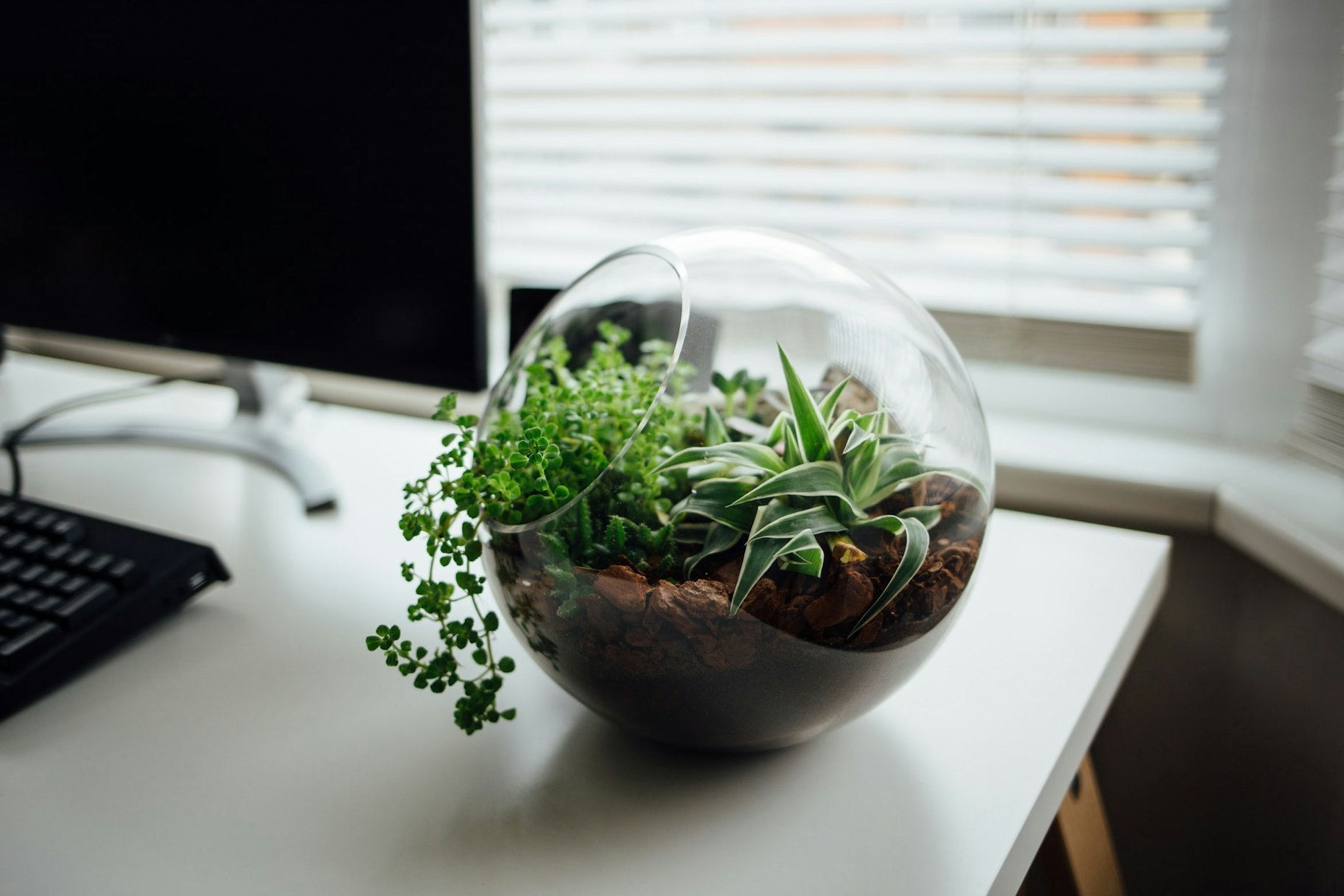
Go forth and harvest
Plants might not be the most popular item to sell online, but they certainly have an audience and can make you good income provided you get the value proposition right. As an added benefit, plants are known to reduce stress and boost productivity, counteracting the stress that comes with opening a new business. Plus, with more and more people interested in becoming plant parents, there’s no better time to cultivate the greens than now.
Selling plants online FAQ
Do I need a permit to sell plants online?
This varies from country to country or even state to state. Additionally, the type of product you intend to sell may determine whether or not you’ll need a specialized permit. In California, for instance, you’re required to have different permits for selling seeds and nursery stock.
Can I make money selling plants online?
Absolutely. If you follow the steps mentioned in this guide, you’ll be on your way to building a profitable online plant business. Just remember, it can take a while to see a profit on your investment. In the initial stages, it’s best to invest any earnings back into the business to run paid ads or buy inventory. Adjust your expectations at the start and you’re more likely to lay a solid foundation for growth.
What plants can I sell from home?
If you live in a place that has optimum conditions for plant growth, you can pretty much sell any plant from home. Consider beginning with varieties that are hardy and compact, such as succulents. Such plants are easy to package, and most are uncomplicated to care for.



